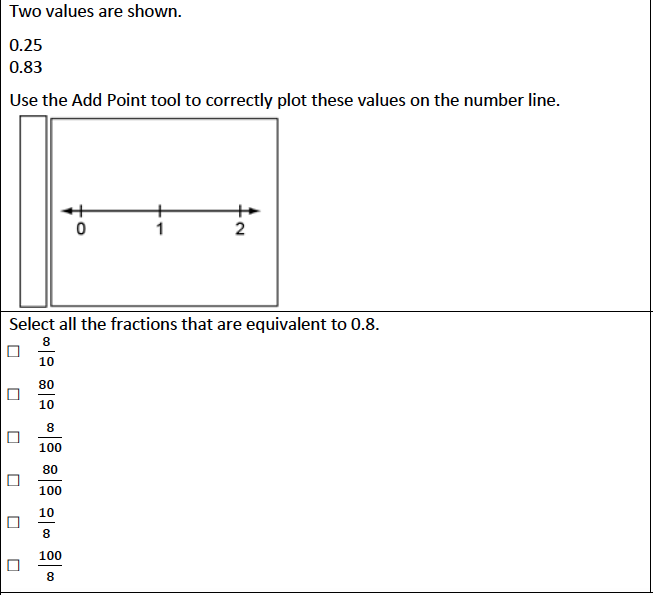Use decimal notation for fractions with denominators 10 or 100. For example, rewrite 0.62 as 62/100; describe a length as 0.62 meters; locate 0.62 on a number line diagram.
[divider] [/divider]Students are able to…
- Model, read and write fractions with denominators of 10 and 100 using models including base-ten blocks and grid paper, extend place value charts, grids and number lines.
- Represent fractions in decimal notation and understand that they are two ways of writing the same quantity.
- Demonstrate understanding that 1/10 is one of 10 equal size pieces and 1/100 is one out of 100 equal size pieces.
[divider] [/divider]Students are able to…because teachers…
- Introduce decimal notation as an extension of whole number place value, where one place value to the right of the one’s place is tenths, and two place values to the right are hundredths.
- Support students’ connection of fractions to decimals.
- Provide ample opportunities for students to with tenths and hundredths using models, pictures, words and numbers.
[divider] [/divider]Questions to ask students:
- What is the value of the digit 5 in 23.54?
- Sample answer that indicates understanding: The student correctly answers the value of the digit 5 is 5 tenths or o.5 (or the value of the 4 is 4 hundredths or 0.04).
- Sample answer that indicates an incomplete understanding or a misconception: The student answers tenths (place value rather than value) or is incorrect with their response (ex. 5 hundredths).
- How does the value of the digit 5 in 23.54 relates to one whole?
- Sample answer that indicates understanding: The student correctly explains that 5 tenths means there are 5 out of 10 parts to make the next whole one (or there are 54 parts out of 100 parts to make the next whole one.)
- How can you rename 2/100 as a decimal?
- Sample answer that indicates understanding: The student correctly renames the value as 0.02 or .02.
- How can you rename 0.34 as a fraction?
- Sample answer that indicates understanding: 34/100 can be represented as 0.34.
[divider] [/divider]FSA Notes
Cognitive Complexity Level: 1: Recall
Achievement Level Descriptors:
2 – writes decimal notation for fractions with a denominator of 10, and vice versa, with visual models
3 – writes decimal notation for fractions with denominators of 10 or 100, and vice versa, including locating on a number line
4 – writes decimal notation for fractions greater than 1 with denominators of 10 or 100, and vice versa, including locating on a number line
5 – [intentionally left blank]
Assessment Limits:
Denominators are limited to 10 and 100.
Decimal notation is limited to tenths and hundredths.
Items may contain decimals or fractions greater than 1 and/or mixed numbers.
[divider] [/divider]Additional Resources:
Additional in depth content knowledge
Blog Post: 4th grade relating fractions to decimals
Video: Connection fractions and decimals
Identifying tenths on a number line
Identifying hundredths on a number line
[divider] [/divider]Sample Formative Assessment Tasks:
Resources/Tasks to Help Your Child at Home:
Using a deck of cards, have your child choose a number 1-9. Have them create that number as a fraction with a denominator of 10. Have them represent the fraction using an area model or number line. Then determine what the equivalent fraction with a denominator of 100 would be, and the equivalent decimals. (Example: I choose a 2. I can represent it as 2/10, or 20/100, 0.2 or 0.20).
Khan Academy: Writing a Number as a Fraction and a Decimal https://goo.gl/jC4xEN

